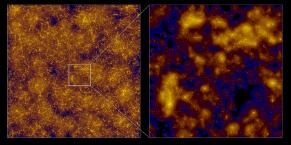
The Universe is filled with an immeasurable number of galaxies that themselves are accumulations of billions of stars. Understanding how these 'islands in the universe’ formed and evolved and how they are distributed throughout the Universe is central to the field of Cosmology. Luckily, we now live in an era where both ground-‐ and space-‐based telescopes are being designed to study the Universe out to unprecedented distances, peering back billions of years to when the Universe was an infant. But the interpretation of these data requires theoretical models. As such, astronomers generate model universes, where galaxies are simulated, which may act as a test bed for the assessment of theories. However, such virtual universes are computationally expensive, numerically challenging, and often lack the sheer number and details of the galaxies we observe.
Now, an international team led by Prof. Alexander Knebe from the Universidad Autonoma de Madrid and Prof. Francisco Prada from the Instituto de Astrofisica Andalusia (bringing together experts from South America, the USA, Europe, and Australia) has created one of the largest publicly available virtual universe, known as the “MultiDark-‐Galaxies”. What is provided to the community are galaxy catalogues based upon three distinct models that all include the physical processes relevant for galaxy formation and evolution, conforming to and reproducing specific empirical observations.
All data is available via the database www.cosmosim.org (hosted at the Leibniz-‐Institut for Astrophysics Potsdam in Germany) and a selected set of properties via www.skiesanduniverses.org (hosted at NMSU in the US and the Instituto de Astofísica de Andalucía CSIC in Spain). The more than 100 million virtual galaxies per model cover a cosmological volume comparable to that probed by on-‐going and future observational campaigns. They therefore equip researchers in the field with an unparalleled opportunity to better understand existing observations and to even make predictions for upcoming missions. More information is available in the accompanyingpaper that has just been accepted by MNRAS and can be found on the arxiv: 1710.08150.
Universidad Autónoma de Madrid © 2008 · Ciudad Universitaria de Cantoblanco · 28049 Madrid · Phone: +34 91 497 51 00 · e-mail: informacion.general@uam